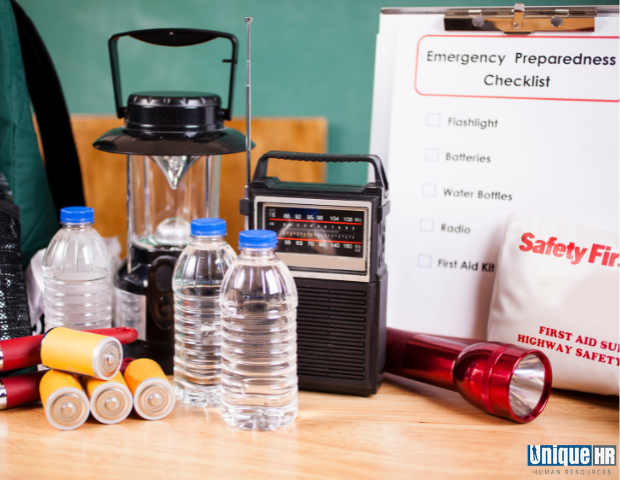With hurricane season upon us, it’s essential to prepare by stocking up on supplies, determining potential risks, checking insurance, and developing an evacuation plan.
Being prepared also applies to the workplace, as employers are responsible for providing an evacuation plan that ensures workers can get to safety if a hurricane affects the area.
According to the Occupational Health and Safety Administration, businesses must maintain an action plan that meets the requirements of regulation 29 CFR 1910.38.
There should be specific conditions to activate that plan, a chain of command, emergency functions, and instructions on who will perform them. There should also be evacuation processes (routes and exits, a way to account for personnel, customers, visitors, and any equipment needed).
These plans must be in writing at the workplace and available for employees to review. There is an exception for an employer with less than ten employees, allowing oral communication.
Here’s a quick breakdown of the required process:
CONDITIONS THAT WILL TRIGGER THE PLAN
This first step involves determining the possible hazards and situations when a hurricane or severe storm begins to threaten the immediate area.
What should you look for in the forecast? Knowing the difference between hurricane/tropical storm watches and warnings is important. A ‘watch’ means a hurricane or tropical storm is possible in the specified area. In contrast, a ‘warning’ means a hurricane or tropical storm will reach the area within 24 hours.
A hurricane brings heavy rain, harsh winds, and flooding that can put employees in danger. Be prepared to know the procedures and instructions from local authorities if there is an evacuation or shelter order.
WHAT’S THE POTENTIAL DAMAGE?
It’s also vital to perform a business impact analysis (BIA) to determine potential impacts and disruptions to normal business processes.
When considering the risk of assets, potential injuries to people are the priority, so highlight those possibilities and how to prepare for and prevent them appropriately. Then, discuss other physical assets such as the building, information technology, utilities, machinery, raw material, and finished goods. Use this time to determine potential weaknesses or vulnerabilities in all assets.
An emergency can also impact your relationships with customers and stakeholders, so consider that to prevent potential loss of confidence in your business or organization.
ASSIGN ROLES AND PREP
During an emergency, assigning roles during an emergency is essential and keeps the situation in order. It’s ideal to have someone who knows the layout of the business, building, and property, to identify exits and the best routes during an evacuation or to the most secure part of the building for sheltering purposes. They should also be in touch with local authorities to become familiar with local safety procedures. Businesses should always be ready for their employees to shelter for at least 24 hours.
Someone should also be familiar with all building or property functions such as ventilation, electrical, water, and sanitary systems; emergency power supplies; detection, alarm, communication, and warning systems; fire suppression systems; pollution control and containment systems; and security and surveillance systems.
Stabilization of a situation also needs to be covered. It consists of one or more people assigned to prevent further damage or injury during an incident, such as administering CPR, first aid, or operating a fire extinguisher.
Running drills ensures that the communications, warning, and protection systems operate as needed during an emergency or to identify gaps or deficiencies.
SUPPLY KITS
OSHA recommends building a reliable supply kit and storing them in hurricane shelter locations. The supplies recommended for such a kit should include:
- One gallon of water per person per day for drinking and sanitation. Store in a cool, dark place and never ration unless instructed otherwise. Reduce water intake by staying fresh and inactive.
- Non-perishable food. Keep in mind foods that employees will eat and try to remember dietary needs and restrictions ahead of time.
- Battery-powered or hand-crank radio
- Flashlight
- First aid kit
- Extra batteries
- Whistle
- Dust mask
- Plastic sheeting and duct tape
- Moist towelettes, garbage bags, and plastic ties
- Wrench or pliers to turn off utilities
- Manual can opener
- Local maps
- Cell phone with chargers and a backup battery
* THIS COMMUNICATION IS FOR INFORMATIONAL PURPOSES ONLY; IT IS NOT LEGAL, TAX, OR ACCOUNTING ADVICE; AND SHOULD NOT BE ACTED UPON AS SUCH. THIS POST MAY CONTAIN HYPERLINKS TO WEBSITES OPERATED BY PARTIES OTHER THAN UNIQUEHR. SUCH HYPERLINKS ARE FOR REFERENCE ONLY. UNIQUEHR DOES NOT CONTROL SUCH WEBSITES AND IS NOT RESPONSIBLE FOR THEIR CONTENT.


